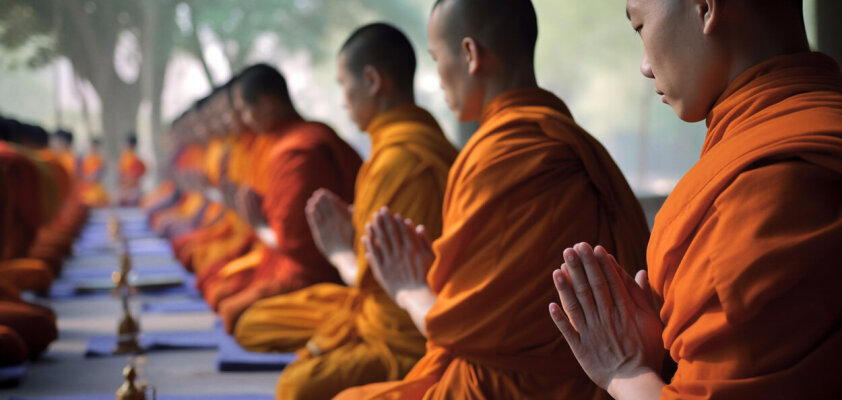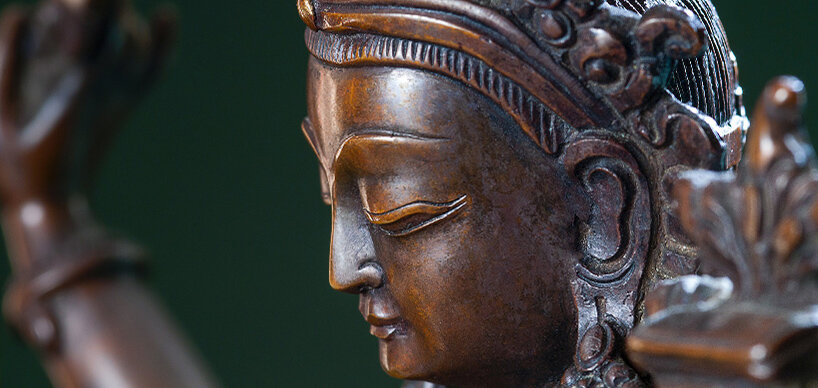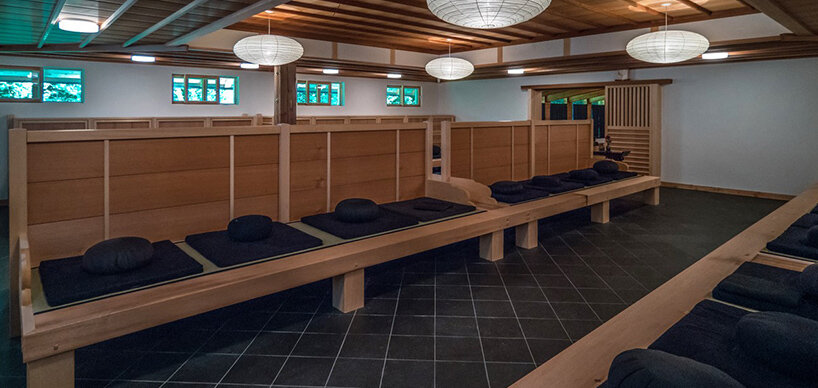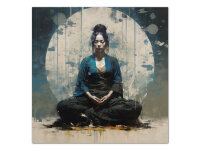Understanding Zen Buddhism

Even though Buddhism, especially in the form of Zen, has made its way to the West in recent times, this topic may still seem foreign and peculiar to many. Who is Buddha? What do Zen and frogs have in common? And how does one attain enlightenment? Our brief introduction helps to understand that Zen Buddhism is not as difficult to grasp as it may initially seem.
Religion or philosophy?
Buddhism originated in India and then spread to Japan through China. Shinto is the traditional Japanese religion and is as old as Japanese culture itself. However, since this belief arrived on the island in the 12th century, it has been warmly welcomed by many residents. About a third of all Japanese people are Buddhists, while approximately 60% do not identify with any religion.
Although Buddhism is a religion like any other, it has its peculiarities and is practiced differently in various parts of the world. First and foremost, it's important to understand that there are two major branches: Hinayana and Mahayana. In the former, Buddhism is practiced more as a philosophy than a religion because in Hinayana, Buddha is not equated with a god but seen as an ordinary person who achieved Nirvana—the Buddhist paradise. This is the goal of those practicing Hinayana. More widespread, however, is Mahayana, the form of Buddhism that includes Zen. Here, the goal is to liberate not only oneself but all living beings from suffering. While Buddha is an idol, the Buddha Nature is also considered to exist in every living being. Buddha means "the Enlightened One," and anyone can become a Buddha—someone who is wise and fundamentally benevolent.
One distinctive aspect of this belief is that one doesn't necessarily have to believe in higher beings, although Buddhism in Japan does have deities that people can pray to, such as Jizo, the protector of travelers and children. "Praying" in this context might involve reciting a mantra, a sentence repeated during meditation, or offering small gifts. Hence, many statues of Jizo are adorned with little knit hats or hand-sewn bibs that were traditionally worn by children, symbolizing protection for them in their next lives. Traveling in Japan, you'll encounter many other elements related to Zen Buddhism.

From monk to souvenir
In Kyoto stands the oldest Zen temple in the country: Kennin-ji, founded in 1202 by the monk Eisai, who is credited with bringing Zen Buddhism to Japan. There are three traditional schools of Zen Buddhism in Japan, with the largest being Soto. Daisetsu Suzuki, a scholar and author, who played a significant role in introducing Zen Buddhism to the West in the last century, belonged to the Soto school. Another key figure with the same surname, Shunryu Suzuki, though unrelated, contributed just as much. These are just a few notable personalities in the history of Buddhism. Of course, the most important figure is Buddha himself.


The Buddha we often encounter in the form of statues and paintings was named Siddhartha Gautama and was the son of an Indian king. His family shielded him from all the evils of the world, providing him with everything his heart desired. However, when he left the palace one day, he encountered poverty, hunger, disease, and death for the first time. He realized that there was suffering in the world and sought a way to free others from it. When he discovered meditation, he realized that the path to liberation from suffering lay within one's own mind. To find this path for himself, he sneaked out of the palace and lived for six years with companions, known as ascetics, in a forest. There, he perfected the art of meditation and attained enlightenment, becoming the Buddha – and thus, Buddhism was born. For another 45 years, Buddha spread his teachings as he traveled through northern India until he passed away.

Another monk is the central figure and founder of Zen Buddhism. His name is Bodhidharma, and he lived in the 5th or 6th century in China. Bodhidharma taught Buddhism as a practice rather than a concept that could be learned through scriptures. Since little is known about him, many legends surround him. As a visitor to Japan, you will inevitably encounter him in the form of red-gold, somewhat angry-looking, round figures with large white eyes. They are called Daruma. The white eyes are meant to be painted: the first one after making a wish. Once the wish comes true, you paint the second eye of the Daruma. Almost every Japanese person has this figurine at home, and it is a popular souvenir – even if not every tourist knows the true meaning behind it.
Wisdom of Buddhism
The Buddhist paradise, Nirvana, is the state one reaches when climbing the highest stage and becoming a Buddha. It comes directly after enlightenment, and it is not a place but a state of mind and detachment from existence. At that point, one is no longer reborn, as the belief otherwise dictates. All beings must go through countless rebirths in the cycle called Samsara until they reach this point. Death is just one stage in the long journey that each of us must take. In Zen wisdom, reincarnation is described as follows:

“Water solidifies into ice, ice melts back into water. What is born will die again; what has died will live again. Water and ice are ultimately one. Life and death, both are as they should be.”
Those who have already attained enlightenment but still choose to be reincarnated are called Bodhisattvas. They want to help others out of compassion to walk the same path and voluntarily refrain from entering Nirvana until all beings have attained enlightenment. Jizo is also a Bodhisattva.

At the same time, in Zen, the Buddha is just one of the so-called Three Jewels of Buddhism. The other two are Dharma and Sangha. Dharma, translated from the ancient Indian Sanskrit language, is the teachings of Buddhism, the ultimate truth underlying it. At the beginning, all Buddhists learn the Four Noble Truths that Buddha experienced on his journey:
- Suffering: It is inevitably part of our life and earthly existence.
- The Origin of Suffering: Suffering arises from unfulfilled desires and pain, both mental and physical. Suffering also arises from losing many things in the course of our lives that we were attached to, as Buddha's quotes state: "Man suffers because he desires to possess and retain things that are by nature transient." A third type of suffering is the dissatisfaction of not having attained enlightenment yet.
- The Cessation of Suffering: In Buddhism, everything in the world is one. There is no "I" and "You," and therefore no dualism. Everything arises from emptiness, and returning to this emptiness is the goal of all beings. Then they can be liberated from suffering.
- The Path of Practice: Buddhism can help in attaining enlightenment and thus ending all suffering.
Meditation: sitting and being hit
How do you overcome this state of imperfection and achieve enlightenment? The most well-known and important method for this is meditation, called Zazen in Zen Buddhism. The word Zen, which also comes from Sanskrit, roughly means "Meditation." Accordingly, meditation is also the central element of this religion.
Traditionally, one meditates in the Zendo, a kind of meditation room typically found in a Zen temple. Meditation cushions called Zafu help find the right position. In the Japanese Soto school of Zen, the Zen master often even carries a wooden stick with which he can give blows to the meditators. However, this is not a punishment but voluntary and does not hurt: Blows to the shoulders are meant to help the student regain concentration if they have drifted off. In the particular form of Zen meditation, one sits like this:
- Legs: In the Lotus position, place the right foot on the left thigh and the left foot on the right thigh.
- Hands: Place the right hand, palm up, on the left hand so that both knuckles of the respective middle fingers touch. The thumbs point toward each other and only lightly touch, as if holding a piece of paper between them. This posture is called Mudra.
- Arms: They should be a bit away from the body, as if holding a raw egg under each upper arm. The thumbs are approximately at the level of the navel.
- Back: As straight and upright as possible, with the shoulders relaxed.
- Head: Stretched towards the sky, slightly tilted forward, as if something is resting on it.
- Eyes: They are not closed but should gaze about one meter in front of you on the ground.

The posture in Zazen can be challenging for beginners. If you want to start meditating, you should sit in a way that is comfortable for you. Only the back should be straight, and the rest of the body relaxed, so you can fully concentrate on your inner self. The reason why Zen pays such strict attention to what the body is doing is the belief that mind and body are inseparably connected. Crossing the legs creates a connection between the two halves of the body, just like the hand posture.
Only for Buddhists?
Even if one does not believe in enlightenment and rebirth, daily meditation is an activity that brings many benefits: it makes one more relaxed, focused, improves sleep, and promotes living in the present moment without unnecessary rumination – the concept of mindfulness. Meditation can also support healing, both in the body and the mind. It's not surprising that Zen is colloquially associated with inner peace and the ability to remain undisturbed by external factors.
Unfortunately, many think that meditation is not for them because they have difficulty clearing their minds and relaxing. However, this is not the goal of Zazen – it is more about becoming aware that thoughts are present. Instead of trying to banish them, one should acknowledge and then let them go. The idea is that these thoughts won't linger for long, naturally fading away. This can lead to freeing the mind. For Buddhists, the aim is not to achieve something new but to rediscover something that has always been there. In this case, it is the "big mind": a mind not oriented towards anything other than itself; a state before all thoughts and ideas.
In his work "Zen Mind, Beginner's Mind," monk Shunryu Suzuki wrote: "You should always be like a frog. That is true Zazen." The frog always practices Zazen by sitting and not thinking about anything, let alone having the intention to do something special. Thus, Zazen is present in every activity: whether lying in bed, eating, walking, or meditating cross-legged. The moment we think we are doing something special or trying to achieve something, our thoughts wander, and we lose ourselves. The key is to do everything mindfully – with undivided attention and in the present moment. In Zen, time is more of an illusion because only the present matters. Since in Zen Buddhism, mind and body are not separate – like everything in the world – it is customary during meditation to focus on the body and breathing. Don't think – feel!
In Buddhism, meditation is not the only way to lead one's life towards enlightenment. It also involves compassion towards others and the principle of not causing harm. Since everyone is only a part of a larger whole, every action reflects back on the doer – the principle of Karma. Making others happy will bring happiness to oneself. Therefore, Buddhists do not eat meat and largely avoid animal products. Additionally, one should not ingest substances that cloud the mind and consciousness, including alcohol, and refrain from sensual indulgences. How Buddhists behave in one life has consequences for the next life during reincarnation: it determines whether they are born as animals or humans, in rich or poor circumstances.
Good life in the Zen temple
As a guideline for the "right" or "complete life," leading to enlightenment, the Noble Eightfold Path is considered in Buddhism. This is divided into "Wisdom," "Ethical Conduct," and "Mental Discipline." Meditation and mindfulness are the final paths. However, this also involves consciously directing one's own thoughts and consciousness, as well as words and actions, to do good for others and serve one's own happiness. Therefore, many life lessons and sayings in Zen, such as the proverb:


“If a problem can be solved, why be unhappy? And if it cannot be solved, what is the use of being unhappy?”
Despite all these teachings, students of Buddhism are encouraged to question everything the Zen master tells them and instead experience it for themselves. A quote from Buddha Siddhartha Gautama therefore states: “Believe only what you yourself have recognized as true.” But even though everyone must practice the Zen on their own and discover the great spirit, it is essential to have others who guide you on the right path. For those who struggle with meditation on their own, guided meditations or instructions can help. These are plentiful on the internet. However, it is even more effective to explore the path of meditation with like-minded people in person.
Sangha, as the third Jewel, therefore means "community" or the Buddhist order. There are even such communities in Germany. For example, the Zen Center Johanneshof Quellenweg in southern Bad Säckingen, which has been providing accommodation for the non-profit organization Dharma Sangha with some Zen monks for 20 years and welcomes guests who want to get to know Buddhism.
The Zendo at Johanneshof-Quellenweg is a good example of the aesthetics of traditional Japanese craftsmanship. This website provides information about the structural development, materials, some peculiarities of Japanese craftsmanship, and the significance of the Zendo: https://www.dharma-sangha.de/zendo-projekt/

One can experience the typical daily life in a Zen monastery, for example, in a so-called retreat. For a few days or weeks, you can become part of a Sangha. This means waking up and going to bed with the sun, meditation several times a day, simple household chores that maintain the community, as well as readings and lectures by the Zen masters. It is important to know that it is something completely different from a wellness vacation: two vegetarian meals a day, only the most necessary possessions, and a simple mat with a wooden pillow and a thin blanket during the stay complete the simple but potentially liberating living conditions.
So, if you ever miss a quiet, relaxed time just for yourself, need a "Digital Detox", or simply want to discover a different way of living, you don't have to travel all the way to Asia. If you open yourself to the new without reservations, wish to be mindful and happy, and are ready to get to know yourself better, you have already taken the first and most important step.
















-from-the-yakiyaki-grill-pan.jpg)




